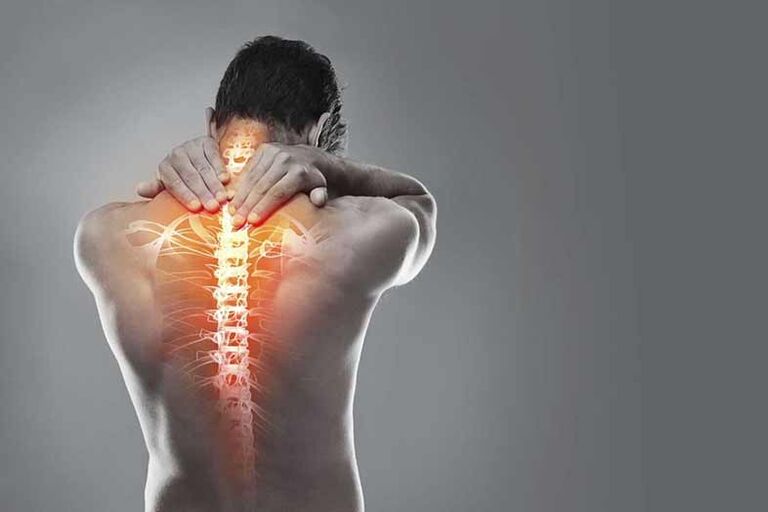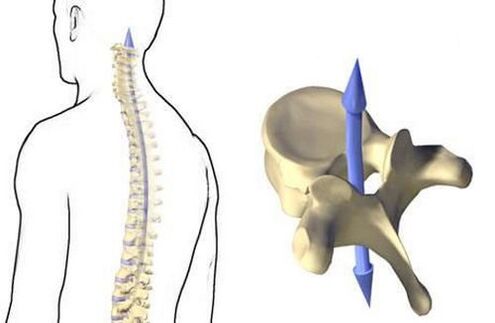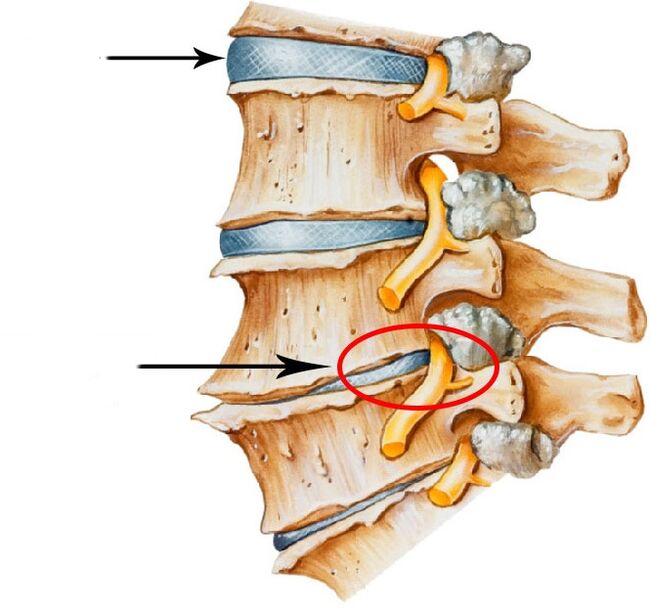
According to statistics, almost half of people already aged 30 to 55 suffer from osteochondrosis.The lower age threshold of the disease in recent years has decreased to 18 years.
What is osteochandrosis
Osteochondrosis of the spineHe is expressed in the defeat of the intervertebral disc, which loses its elasticity, its elasticity, its cracks.
Cervical osteochondrosisAssociated with damage to discs of the cervical column.
How the spine works
If for a better understanding, somewhat simplified essence, the spine device can be described as follows.
The spine consists of separate, similar to each other in the form of vertebrae located one above the other.
Despite some differences in form, in the structure of all vertebrae, there is a current.There is a hole in each vertebra - all the holes are also one above the other and form a vertical channel (tunnel) crossing the entire spine.
Inside this vertebral channel, the spinal cord passes.It passes vertically through the holes in each vertebra, and its roots (branches, in which the endings of the sensitive nerve) leave the canal between each pair of vertebrae.This is possible because the vertebrae are not lost with each other and are not closely fixed, and between each pair of vertebrae, there is cartilage - an intervertebral disc.

The wheels as well as the ligaments connect the vertebrae with each other, and also play the role of the shock absorber.Due to their elastic structure, they are elastic tablet during movements and inclinations of the body (on the inclination side) or not covered (during recovery).Thus, the discs offer the spine the flexibility and soften the load of the vertical pressure from top to bottom with each vertebral vertebra of the spine, as well as the vertical vibrations up which occur during walking or running.After all, a person is a unique creature on the right and simple.
Such work of the spine is ensured if the whole load is properly distributed.Nature has created the incredibly stable, robust and flexible spine.
And if not?
If the shape of the spine, designed by nature, for any reason is raped (by, excessive curvature in the lower back, scoliosis, flat feet) or a constant chronic habit of sitting, lying, standing, intervertebral compounds begin to wear out, to lose their elasticity, to the capacity to perform the shock absorption function.They enter the sides, forming hernia.
The wear and tear of intervertebral discs - there is also a person's calculation for the amount.After all, only in humans the spine has a vertical load.Such a vertical compression throughout the life of all the components of the spine (especially in people with an excess weight) leads to a progressive deterioration of the blood supply with the intervertebral discs (the vascular direction is pressed) - the disc loses endurance and force.
What to follow?

Hernia Disc ContinueBlood vessels,,Nerve rootsand sometimesspinal cord.
The consequences of cervical osteochondosis
Due to changes in anatomical relationships in the spine, blood vessels (the main arteries and veins) are in a hurry.
What is happening:Due to changes in anatomical relationships in the spine, blood vessels (the main arteries and veins) are in a hurry.What leads to:
- to a violation of the blood flow in the brain and to a violation of a complete nutrition of the brain.
- to a violation of the venous flow and to the accumulation of toxic substances in the tissues of the brain.
How it manifests itself:
- Dizzy (up to a loss of short -term consciousness).
- Headache.
- Visual impairment.Violation of smell, taste.
- Bulbar disorders associated with the difficulties of swallowing, pronunciation, violation of general breathing and the breathing of speech.
- Cognitive disorders: altered memory, perception, complexity with concentration of attention, complexity with logical thinking.Reading violation.
- Absent -imbededness.Inappropriation.Decrease in confusion.Oversight.
- Difficulties with complex and long complex words, complex grammatical constructions.
- Reduced performance, overwork.
- Violations in the emotional and personal sphere: clear and unreasonable mood swings, emotional incontinence, irritability, anger.
Diagnostics: Cognitive disorders, aphasia, bulbar dysarthria, disoritable encephalopathy, vertebro-baslar insufficiency (VBN), etc.can be diagnosed. Drug therapy taken in these cases:
- Vascular drugs.They have an extremely low evidence.They require the use of the doctor and under the control of a doctor, they can cause a large number of different complications and side effects.
- Nootropic drugs.Require strictly use for the appointment and under the control of a doctor.Many have fairly serious contraindications in the cardiovascular system (with a hidden cardiac pathology, serious negative consequences can cause).Most nootropes have no positive pharmacological result, that is to say that it is useless.
- Sedative effects, including tranquilizers, antidepressants, barbiturates, bromures.Psychotropic drugs.Require strictly use for the appointment and under the control of a doctor.They can be addictive and have several side effects (dizzy, headache, visual disturbances and urilation, dry mouth, nausea, etc. Shame disorders, a decrease in libido, sleep disorders, a set of body weight).
There is a compression (compression) of nerve roots - the nerves coming from the spinal cord towards the organs and the tissues of the upper body.
What is happening:
There is a compression (compression) of nerve roots - the nerves coming from the spinal cord towards the organs and the tissues of the upper body.
What leads to: To a pronounced, often chronic, recurring pain syndrome.
How it manifests itself:
- Pain in the neck, at the back of the head (with turns of the head or at rest, shots or chronic).
- The headache (tension headache associated with the tension of the muscles of the posterior surface of the neck and the head of the head - the pain, poured over the head, often accompanied by noise and ringing in the ears, fly before the eyes).
- Pain in the top of the chest.
- Pain that simulates pain in the heart, in the lungs.
- Pain in the upper back in the shoulders, shoulders.
- Pain in the shoulder joint or in the whole hand.
- Numbness of the fingers, hands, hands completely.
Drug therapy taken in these cases:
- Non-steroidal anti-inflammatory drugs (analgesic, antipyretic), requiring the use of strictly for the appointment and under the control of a doctor and have lateral reactions of the gastrointestinal tract (gastritis, ulcers, ulcerative bleeding), cardiovascular system, kidneys.
- Preparations that relieve muscle hypertonicity, requiring strictly use for its planned objective and under the control of a doctor and have lateral lateral reactions in the form of strong stunning, weakness at completely exhausting height.
The use of medication is the most common practice in the treatment of osteochondosis.However, it is a symptomatic treatment.Drugs are used to stop inflammatory processes and pain (sometimes you should use novocaine blocking), a decrease in neurological and psycho-emotional symptoms.The most important thing is that pharmacological therapy occurs under the strict supervision of a doctor.
However, if you do not directly stop the process of violating the vessels, do not restore the balance of the spine and all the related structures posed by nature (violation of body symmetry, flat feet, muscle cramps that occur in the form of a compensatory reaction to balance), the disease will not go and at a given moment, it does not helpto operation.
Osteopathic treatment aims to eliminate the above causes of osteochondrosis, which is now recognized as the most effective.
Osteopathic treatment of osteochandrosis
Rule n ° 1 "The sooner, the best" in the case of osteochondrosis, it works above all!After all, cure osteochondrosis - means not to turn off pain or other syndromes, but restore the normal position of the spine, to provide the intervertebral disc with lost nutrition (to turn normal blood supply) before the degenerative processes of the cartilaginous tissue will become irreversible.
The osteopath determines the place where the displacement or the deformation has occurred, findsThe reasons why ships in ships in the spine have occurred.Osteopathy considers the body as a unique system in which everything is interconnected and displayed, literally draws one after the other.This means that the osteopath restores the work of all the structures, the changes in which in the chain have led to a violation of the power of the intervertebral disc.The task of the osteopath is to restore the equilibrium report of the organs and tissues, eliminate the constraints and the pliers that interfere with complete nutrition.And if, in the case of a neglected condition of the disease, the changes in the structure of the spine led to a violation of the work of the internal organs, an osteopathic treatment will aim to eliminate emerging dysfunctions.
In other words, the osteopath works with the deep cause of the disease, and not with the elimination of its syndromes, including pain.Although he will start his work with this, with the relief of pain.However, that will not stop there.The best way to osteopathy works in combination with physiotherapy (ensures a decrease in pain and inflammatory processes) and physiotherapy exercises - exercise therapy (strengthens the muscle corset, helps the body to stay in a new unusual but appropriate).
Conclusions
- The neck cannot be treated in a frivolous way.Because the brain should be provided with without hindrance nutrition.And it depends on the quantity that the neck is a healthy "driver".
- You can't wait.The more the disease is launched, the more difficult it is to make it go back (and sometimes impossible).The osteopath is able to determine the disease when it is still in rudiment and does not manifest itself in any way.You should never neglect a diagnostic examination.
- It is impossible to neglect the prevention of osteochondrosis.It is always easier than treating the disease.

























